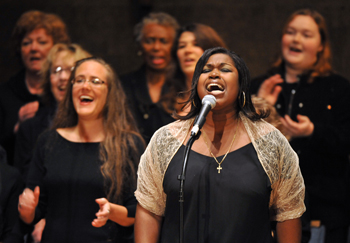
When most people listen to music, they are almost invariably drawn to the melody. The melody is usually the main idea of any piece of music. If the music has a solo singer, the singer's part is almost always the melody. In terms of a specific definition, we can think of the melody as a series of single pitches, sounded one after another that we perceive as a unit, a recognizable whole.
Melodies have certain grammar to them, much like sentences. Melodies are generally made up of phrases, which end at cadences. You can think of a phrase as being akin to a section of a sentence, and the cadence is like punctuation, signaling a point of rest and arrival. If you are listening to a piece of music that has lyrics, the musical phrases generally correspond to the poetic structures and rhymes. Even if you are dealing with instrumental music, a good trick for hearing phrases and finding cadences is to sing or hum along and take note of where it feels logical to take a breath. A cadence may feel incomplete, as if it's a sort of musical comma that requires completion, or it can be complete, as if it is a period signaling the end of a full musical thought. If we return to the "Star Spangled Banner," we might consider that the cadence at the end of the line "By the dawn's early light," feels less complete than the cadence at the end of "At the twilight's last gleaming."
Melodies can move by steps or by large leaps, and most melodies have a mix of both. As an example, the song "Over the Rainbow" begins with a very large leap on the word "Somewhere" followed by movement more or less by step. Melodies in popular music tend to move mostly by steps, reserving leaps for particularly dramatic moments, if only because melodies that move by step are much easier for people to sing. Melodies with lots of leaps are often quite difficult to sing; the best example is probably the “Star Spangled Banner,” which features a number of large leaps across a wide vocal range. For this reason, even seasoned singers sometimes botch it in performance.
Harmony
 If melody is the "horizontal" aspect of music in the world of music notation, then harmony is the vertical, covering sounds that occur simultaneously. When multiple pitches are sounded at once, they result in a chord. As we will see, harmony is governed by a series of expectations much like the cadences and phrases of melodies. This lesson and our discussion of key in the next lesson are very closely interrelated. Most chords in Western music are built as three-note triads, which are constructed by picking every other note out of a scale (more about scales in a moment!)
If melody is the "horizontal" aspect of music in the world of music notation, then harmony is the vertical, covering sounds that occur simultaneously. When multiple pitches are sounded at once, they result in a chord. As we will see, harmony is governed by a series of expectations much like the cadences and phrases of melodies. This lesson and our discussion of key in the next lesson are very closely interrelated. Most chords in Western music are built as three-note triads, which are constructed by picking every other note out of a scale (more about scales in a moment!)
We can talk about individual chords as being consonant or dissonant, referring to the amount of tension within them. A good way to remember this is to literally think of what the components of these words mean. "Sonance" means "sound," "con" means "together" (convention, conference, conjunction), while "dis" means "apart" (disjunction, disrupt, dispatch). Dissonant chords feel like they need to resolve to a consonance, although composers may play with your expectations and leave you hanging on at times, waiting for the point of rest. When you hear melodic cadences in a piece that includes accompanying harmony, one of the reasons that the cadences feel like points of arrival is that they land on consonances.
Another major reason that complete cadences sound consonant and final is that they use the chord that is built on the tonic, the pitch that functions as a center of gravity in most music. To hear the importance of tonic, sing "do-re-mi-fa-sol-la-ti-do" without arriving to the final "do." Or, check out this nifty little online keyboard. Beginning on C, play each white key up to B (C-D-E-F-G-A-B) and stop before hitting C1. Notice how you likely want to go up to C1...we are conditioned to want that resolution. If you switch the webpage to "Chord Mode" via the button to the left of the keyboard and press down C-E-G, you will get the tonic chord. Play the scale again and follow it by outlining the chord notes C-E-G. Notice how the chord seems to confirm the tonic as a home base. In our next lesson, we'll see how this home base functions within larger pieces of music.